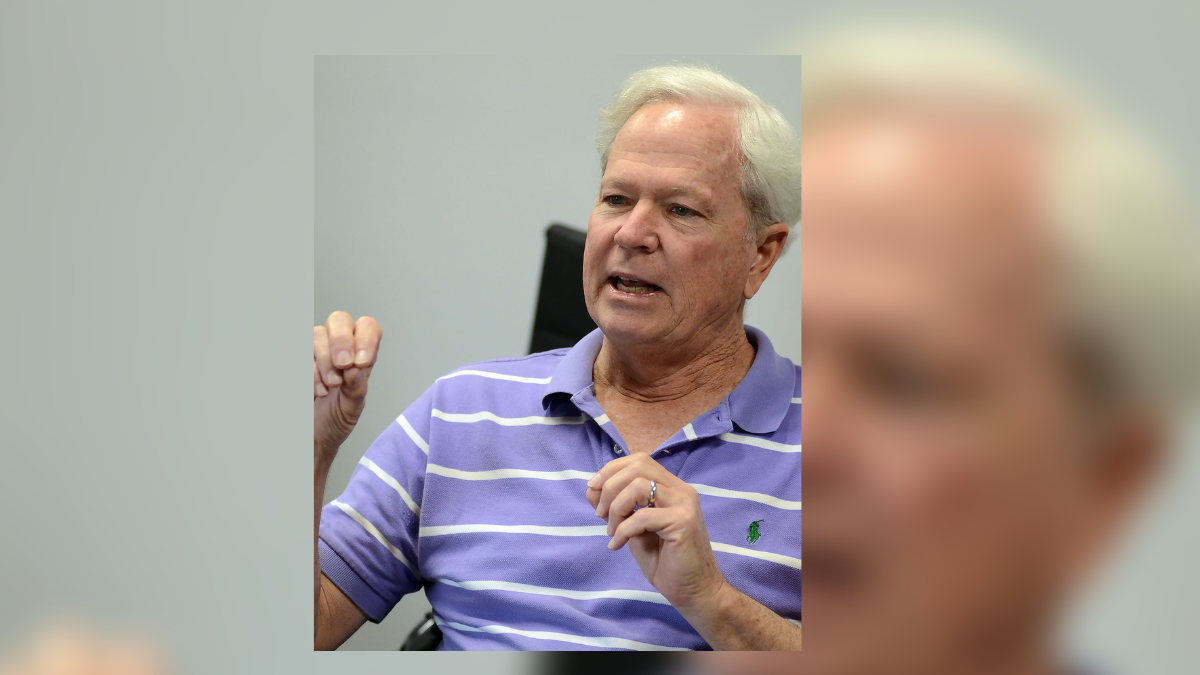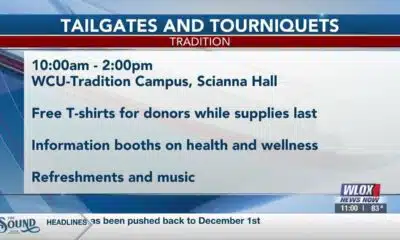Mississippi Today
Rebuilding trust: How Ted Henifin hopes to repair the relationship between Jacksonians and their water system
Rebuilding trust: How Ted Henifin hopes to repair the relationship between Jacksonians and their water system
Eager to spread the news of a massive federal investment in his city’s drinking water system, Jackson Mayor Chokwe Antar Lumumba called several town hall events over the last few months to update his constituents.
But to the residents in attendance, the $800 million coming to Jackson is far less tangible than the problems right in front of them, as many directed the same, commonly heard refrains towards Lumumba: What is with my water bill? Why am I being charged for water that’s unsafe to drink? Who’s going to fix the sewage spewing onto my lawn?
“I’m being charged for water I’m not even using,” one man said at a Forest Hill High School town hall in February, saying the water he was being charged for was leaking across his yard.
A woman in attendance said her monthly bill went from $55 to over $200, which she eventually just refused to pay. At another town hall in December, a resident said he got a bill in the thousands even though the water from his tap was brown.
Unable to speak to each person’s problem, Lumumba echoed a hopeful sentiment: While the city didn’t have the resources it needed before, it does now, and help is on the way.
While much has happened for the future of Jackson’s water since last fall – a federal takeover that placed a third-party team in control of the system’s improvement, the $800 million investment provided through several federal funding streams, a grant program that’s already eliminated $8 million in resident’s water bill debt in less than a week – the process of restoring trust among residents in what comes out of their taps is a long road ahead.
“I mean we’re going on, what, 40 years of distrust in Jackson’s water system?” said Brooke Floyd, a coordinator with the JXN People’s Assembly.
Floyd, a Jackson native, mother, and former teacher, said she distrusted the water even as a child, recalling her grandparents boiling the water for as long as she remembers.
“People are centering this on (the current) administration, but this is a deep-seated distrust that goes for years,” Floyd said. “So, I think it’s going to take some time for residents to understand, and it’s going to take some showing; you have to show people that the billing is going to get straightened out, and that our water is safe and that the pipes work, all those things.”
Last November, a federal judge appointed Ted Henifin to be the one in charge of lifting Jackson’s water system into a state of self-reliance.
Henifin recently sat down with Mississippi Today to talk about his game plan, as well as rebuilding trust in a water system among the people who have to pay for it.
Henifin said restoring credibility comes down to three changes: fixing the billing system, providing consistent water pressure by replacing small water lines and finally clarifying the existence of lead in Jackson’s distribution system.
Henifin’s plan
After working for 40 years in Virginia, it wasn’t until getting to Jackson that Henifin realized being a municipal utility worker could earn him public notoriety.
“People will recognize me pretty much everywhere I go, which is a little weird,” Henifin told Mississippi Today at his office. “I’ll be going out to dinner and people will say, ‘Oh, you’re the water guy.’”
But Henifin is in a city where such basic services – whether it’s garbage pickup, sewage disposal or drinking water – regularly leave residents without guarantees. He’s also in a position where few very, if any, municipal water professionals have ever sat.
In one of the largest federal interventions of a local utility system in American history, the U.S. government equipped Henifin with far-reaching authority that allows him to bypass local and state regulation, as well as nearly a billion dollars to spend on projects and a $400,000 personal salary.
His new title is chief executive officer of JXN Water, a nonprofit established to carry out the federal order put in place in November.
Although he’s heading a non-public entity that can avoid public record laws and government procurement rules, Henifin said he’s committed to transparency.

At the December town hall, Henifin waited afterwards to greet attendees, handing out his phone number to anyone who asked. While he said connecting with people directly is important for him to build credibility with Jackson residents, he admitted it’s been a little overwhelming at times trying to get back to everyone who reaches out.
But restoring trust is more than just being a personable face. Henifin said he wants residents, who will have to fund the water system once he’s left and the federal money has dried up, to feel that they’re paying into something worthwhile and that they’re being charged fairly.
“The billing system’s not helping us whatsoever at the moment, sending out terrible bills and continuing to struggle answering calls,” he said. “The trust-building where (residents) connect to us, which is really billing, is the big piece.”
While it’s a widely accepted practice for cities to charge customers based on how much water they consume, Jackson hasn’t had a reliable metering system in place for years due to the fallout from a failed Siemens contract, and residents are constantly burdened with inconsistent or incorrect bills.
As part of a debt relief program – funded through a new social safety net grant created under the CARES Act – Jackson last week began offering to correct water bills for customers who felt they were given incorrect charges. In less than a week, the city corrected $8 million in residents’ debt.
Recognizing the damage the broken water meters had done to the whole system’s credibility, Henifin in January laid out a novel approach in a financial proposal he was required to submit by the federal order: charging residents based on their property value. He conceded then that, as far as he knew, the only city to try something similar was Milwaukee with its wastewater system.
According to an analysis he presented, this system wouldn’t change much for the lower-income and average rate-payers: the median single-family household would see a $50 monthly bill; lower-value property owners would pay slightly less; and and higher-value owners would pay slightly more, with bills capped at $150.
What would change, Henifin explained, is that residents would be getting the same bill amount every month, taking away the monthly mystery that has haunted Jackson customers since the Siemens fiasco.
But on Wednesday, lawmakers passed a bill in the Senate that would ban charging customers for water in a way that doesn’t include consumption. The bill is headed back to a committee for further debate.
Henifin called out the Legislature’s efforts to interfere during a recent town hall at Millsaps college.
“There are so many things we pay for that aren’t directly connected to our use,” he. “We all pay for schools, not all of us have children. We all pay for trash, some people put out tons of trash, some people only put out a bit.
“We’re just stuck in this, ‘water has to be based on consumption’ mindset, but so many other things that are for society we pay for without even giving it much thought, because it’s all about a community that’s supporting the other members of the community.”
Lumumba has yet to comment on the idea, saying he hasn’t seen Henifin’s proposal.
The JXN Water CEO will spend the next few weeks and months at roundtables with community members to hear their thoughts on his idea, among others he put in his January financial plan.
Trusting the water
In 2015, test results for lead in Jackson’s water system showed samples above the “action level,” or legal limit, of 15 parts per billion (ppb). Just months later, the state Department of Health found that nearly a quarter of homes it tested had lead levels above 15 ppb.
The Environmental Protection Agency has since required the city to issue quarterly notices to residents, reminding pregnant women and children to take extra precautions before drinking the water. The EPA requirement is still in place for Jackson because the city has yet to complete a corrosion control plan to ensure no lead or copper dissolves into the water during the treatment process.
“How can you have trust if you have to have that statement on everything you put out about the water?” Henifin said.
He said the system to complete the corrosion control, which the city has put off completing for years, should be in place this summer, which would then allow the city to stop sending the quarterly notices.
But even after fixing the treatment process, the city will still have to ensure there’s no lead in the water lines of the distribution system. Henifin said he has a contractor set to do an inventory analysis of Jackson’s piping to determine if there are any lead service lines, and said that information should be presented to the public within a year.
Jackson is facing multiple lawsuits that allege the city exposed residents to lead, including one representing 600 children that alleges a coverup dating back to 2013.
Danyelle Holmes, National Social Justice Organizer with the Poor People’s Campaign, said that even with the city upgrading its water lines, there is still a concern of the presence of lead in the city’s homes, especially in poorer neighborhoods where pipe replacements are less feasible.
“If they’re old pipes they need to be replaced,” Holmes said. “We know that in south Jackson, and in west Jackson as well, a large portion of those homes are old homes, and those are the homes that we’re concerned will be disproportionately affected.”
In the city’s latest quarterly notice, it disclosed that during the July-December testing period it found the 90th percentile of results showed 6 ppb of lead; while 15 ppb is the legal limit, health experts say that no amount of lead is safe to consume.
Last year, a series of tests conducted by the Clarion Ledger and Mississippi Center for Investigative Reporting found positive results for lead throughout Jackson, with the highest being about 6 ppb at Jackson State University.
Restoring pressure: replacing lines, plugging leaks
Because of leaks throughout the distribution system, the city of Jackson loses about half of the water that it treats and puts out everyday. On average, water systems around the country lose about 15% of the water they put out.

Henifin’s team, led by former Jackson planning director Jordan Hillman, is finding major leaks throughout the city, he said, in some cases by detecting chlorine in puddles that wouldn’t otherwise be there. He projects that, through contracted work, they’ll be able to fix some of the larger leaks within the next two years.
The other issue, though, is the city’s small diameter water lines. The modern standard is that water lines should be at least 6 inches in diameter; Jackson, though, has over 100 miles of lines smaller than that.
Henifin projected it’ll take between five to 10 years to make the necessary fixes, with the goal of doing about 20 miles of replacements each year.
“Hopefully soon after we’ll get the anecdotal stories that people say, ‘Wow, the water’s great, it’s no longer discolored,’” Henifin said. “So, if we get a couple of those stories out by fall, I think by next year we could have some movement towards trust building if (we fix) the billing system, pipe replacement, and we get the corrosion control. Those three things should help to at least begin to build some trust.”
Optimistically speaking, Henifin added, if his team of contractors plug enough of the city’s leaks, Jackson could reach a point within the next year where it wouldn’t need the century-old J.H. Fewell, one of the system’s two treatment plants. City officials have for years hoped to retire Fewell, which would save Jackson “significant money” from not having to operate it, Henifin said.
What’s next
Pending the legislative session and feedback from upcoming community roundtables and city leaders, Henifin hopes to have the new billing system in place by October.
On Tuesday, Henifin also mentioned early talks of Jackson’s wastewater system, which is under an EPA consent decree, joining the drinking water system in the federal stipulated order. But he said that decision is at least a few weeks away.
Looking ahead, Henifin is already thinking about how he plans to leave the city. In his January proposal, he looked at the various options for long-term governance, and suggested the best option would be placing the water system under a corporate nonprofit, similar to JXN Water but with a board of governors made of local constituents.
Under that model, Jackson would retain ownership of the water system assets, and contract out its services. Henifin said while he hadn’t thoroughly researched it, he didn’t know of any water systems in the U.S. with a similar model.
He added that he didn’t think it’d be wise to give the city back full control of the system, citing local politics and obstacles in issuing contracts. He said he’s had that conversation with Jackson leadership, and thinks they may come around to the idea at some point.
“I don’t believe the city has demonstrated that they’re able to do this,” Henifin said. “With a track record like that, what would make any of us think that changes just because there’s an influx of federal dollars?”
On Wednesday, proposed legislation to create a state-controlled regional authority over Jackson’s water system died in the House.
Floyd, the coordinator with JXN People’s Assembly, said she’s encouraged by the work Henifin has done so far, and thinks he’s serious about winning over residents’ trust.
“There’s going to be a lack of trust with whoever is (running the water system),” Floyd said. “I don’t think people are really that worried with (Henifin) being from wherever and coming from the outside. When is the water going to be fixed and when is my bill going to be fixed? That’s the number one concern for everybody.”
In conversations with those affected by the ongoing water crisis, Henifin said he’s been surprised by the empathy he’s gotten from Jacksonians.
“The folks have very high expectations that I might be able to make a difference, but they also seem willing to be patient,” he said. “Much more so than if I was in their shoes and had lost water pressure for weeks during the summer and again at Christmas. I’ve found it actually to be increasing my personal pressure to succeed because so many people have been really nice about encouraging me.”
This article first appeared on Mississippi Today and is republished here under a Creative Commons license.
Mississippi Today
Mississippi prepares for another execution
The Mississippi Supreme Court has set the execution of a man who kidnapped and murdered a 20-year-old community college student in north Mississippi 30 years ago.
Charles Ray Crawford, 59, is set to be executed Oct. 15 at the Mississippi State Penitentiary at Parchman, after multiple requests by the attorney general’s office.
Eight justices joined the majority opinion to set the execution, concluding that Crawford has exhausted all state and federal legal remedies. Mississippi Supreme Court Justice T. Kenneth Griffis Jr. wrote the Friday opinion. Justice David Sullivan did not participate.
However, Kristy Noble with the Mississippi Office of Capital Post-Conviction Counsel released a statement saying it will file another appeal with the U.S. Supreme Court.
“”Mr. Crawford’s inexperienced trial counsel conceded his guilt to the jury — against Mr.
Crawford’s timely and repeated objections,” Noble said in the statement. “Mr. Crawford told his counsel to pursue a not guilty verdict. Counsel did just the opposite, which is precisely what the U.S. Supreme Court says counsel cannot do,” Noble said in the statement.
“A trial like Mr. Crawford’s – one where counsel concedes guilt over his client’s express wishes – is essentially no trial at all.”
Last fall, Crawford’s attorneys asked the court not to set an execution date because he hadn’t exhausted appeal efforts in federal court to challenge a rape conviction that is not tied to his death sentence. In June, the U.S. Supreme Court declined to take up Crawford’s case.
A similar delay occurred a decade ago, when the AG’s office asked the court to reset Crawford’s execution date, but that was denied because efforts to appeal his unrelated rape conviction were still pending.
After each unsuccessful filing, the attorney general’s office asked the Mississippi Supreme Court to set Crawford’s execution date.
On Friday, the court also denied Crawford’s third petition for post-conviction relief and a request for oral argument. It accepted the state’s motion to dismiss the petition. Seven justices concurred and Justice Leslie King concurred in result only. Again, Justice Sullivan did not participate.
Crawford was convicted and sentenced to death in Lafayette County for the 1993 rape and murder of North Mississippi Community College student Kristy Ray.
Days before he was set to go to trial on separate aggravated assault and rape charges, he kidnapped Ray from her parents’ Tippah County home, leaving ransom notes. Crawford took Ray to an abandoned barn where he stabbed her, and his DNA was found on her, indicating he sexually assaulted her, according to court records.
Crawford told police he had blackouts and only remembered parts of the crime, but not killing Ray. Later he admitted “he must of killed her” and led police to Ray’s body, according to court records.
At his 1994 trial he presented an insanity defense, including that he suffered from psychogenic amnesia – periods of time lapse without memory. Medical experts who provided rebuttal testimony said Crawford didn’t have psychogenic amnesia and didn’t show evidence of bipolar illness.
The last person executed in Mississippi was Richard Jordan in June, previously the state’s oldest and longest serving person on death row.
There are 36 people on death row, according to records from the Mississippi Department of Corrections.
Update 9/15/25: This story has been updated to include a response from the Mississippi Office of Capital Post-Conviction Counsel
This article first appeared on Mississippi Today and is republished here under a Creative Commons Attribution-NoDerivatives 4.0 International License.
The post Mississippi prepares for another execution appeared first on mississippitoday.org
Note: The following A.I. based commentary is not part of the original article, reproduced above, but is offered in the hopes that it will promote greater media literacy and critical thinking, by making any potential bias more visible to the reader –Staff Editor.
Political Bias Rating: Centrist
The article presents a factual and balanced account of the legal proceedings surrounding a scheduled execution in Mississippi. It includes perspectives from both the state’s attorney general’s office and the defense counsel, without using emotionally charged language or advocating for a particular political stance. The focus on legal details and court decisions reflects a neutral, informative approach typical of centrist reporting.
Mississippi Today
Presidents are taking longer to declare major natural disasters. For some, the wait is agonizing
TYLERTOWN — As an ominous storm approached Buddy Anthony’s one-story brick home, he took shelter in his new Ford F-250 pickup parked under a nearby carport.
Seconds later, a tornado tore apart Anthony’s home and damaged the truck while lifting it partly in the air. Anthony emerged unhurt. But he had to replace his vehicle with a used truck that became his home while waiting for President Donald Trump to issue a major disaster declaration so that federal money would be freed for individuals reeling from loss. That took weeks.
“You wake up in the truck and look out the windshield and see nothing. That’s hard. That’s hard to swallow,” Anthony said.
Disaster survivors are having to wait longer to get aid from the federal government, according to a new Associated Press analysis of decades of data. On average, it took less than two weeks for a governor’s request for a presidential disaster declaration to be granted in the 1990s and early 2000s. That rose to about three weeks during the past decade under presidents from both major parties. It’s taking more than a month, on average, during Trump’s current term, the AP found.
The delays mean individuals must wait to receive federal aid for daily living expenses, temporary lodging and home repairs. Delays in disaster declarations also can hamper recovery efforts by local officials uncertain whether they will receive federal reimbursement for cleaning up debris and rebuilding infrastructure. The AP collaborated with Mississippi Today and Mississippi Free Press on the effects of these delays for this report.
“The message that I get in the delay, particularly for the individual assistance, is that the federal government has turned its back on its own people,” said Bob Griffin, dean of the College of Emergency Preparedness, Homeland Security and Cybersecurity at the University at Albany in New York. “It’s a fundamental shift in the position of this country.”
The wait for disaster aid has grown as Trump remakes government
The Federal Emergency Management Agency often consults immediately with communities to coordinate their initial disaster response. But direct payments to individuals, nonprofits and local governments must wait for a major disaster declaration from the president, who first must receive a request from a state, territory or tribe. Major disaster declarations are intended only for the most damaging events that are beyond the resources of states and local governments.
Trump has approved more than two dozen major disaster declarations since taking office in January, with an average wait of almost 34 days after a request. That ranged from a one-day turnaround after July’s deadly flash flooding in Texas to a 67-day wait after a request for aid because of a Michigan ice storm. The average wait is up from a 24-day delay during his first term and is nearly four times as long as the average for former Republican President George H.W. Bush, whose term from 1989-1993 coincided with the implementation of a new federal law setting parameters for disaster determinations.
The delays have grown over time, regardless of the party in power. Former Democratic President Joe Biden, in his last year in office, averaged 26 days to declare major disasters — longer than any year under former Democratic President Barack Obama.

FEMA did not respond to the AP’s questions about what factors are contributing to the trend.
Others familiar with FEMA noted that its process for assessing and documenting natural disasters has become more complex over time. Disasters have also become more frequent and intense because of climate change, which is mostly caused by the burning of fuels such as gas, coal and oil.
The wait for disaster declarations has spiked as Trump’s administration undertakes an ambitious makeover of the federal government that has shed thousands of workers and reexamined the role of FEMA. A recently published letter from current and former FEMA employees warned the cuts could become debilitating if faced with a large-enough disaster. The letter also lamented that the Trump administration has stopped maintaining or removed long-term planning tools focused on extreme weather and disasters.
Shortly after taking office, Trump floated the idea of “getting rid” of FEMA, asserting: “It’s very bureaucratic, and it’s very slow.”
FEMA’s acting chief suggested more recently that states should shoulder more responsibility for disaster recovery, though FEMA thus far has continued to cover three-fourths of the costs of public assistance to local governments, as required under federal law. FEMA pays the full cost of its individual assistance.
Former FEMA Administrator Pete Gaynor, who served during Trump’s first term, said the delay in issuing major disaster declarations likely is related to a renewed focus on making sure the federal government isn’t paying for things state and local governments could handle.
“I think they’re probably giving those requests more scrutiny,” Gaynor said. “And I think it’s probably the right thing to do, because I think the (disaster) declaration process has become the ‘easy button’ for states.”
The Associated Press on Monday received a statement from White House spokeswoman Abigail Jackson in response to a question about why it is taking longer to issue major natural disaster declarations:
“President Trump provides a more thorough review of disaster declaration requests than any Administration has before him. Gone are the days of rubber stamping FEMA recommendations – that’s not a bug, that’s a feature. Under prior Administrations, FEMA’s outsized role created a bloated bureaucracy that disincentivized state investment in their own resilience. President Trump is committed to right-sizing the Federal government while empowering state and local governments by enabling them to better understand, plan for, and ultimately address the needs of their citizens. The Trump Administration has expeditiously provided assistance to disasters while ensuring taxpayer dollars are spent wisely to supplement state actions, not replace them.”

In Mississippi, frustration festered during wait for aid
The tornado that struck Anthony’s home in rural Tylertown on March 15 packed winds up to 140 mph. It was part of a powerful system that wrecked homes, businesses and lives across multiple states.
Mississippi’s governor requested a federal disaster declaration on April 1. Trump granted that request 50 days later, on May 21, while approving aid for both individuals and public entities.
On that same day, Trump also approved eight other major disaster declarations for storms, floods or fires in seven other states. In most cases, more than a month had passed since the request and about two months since the date of those disasters.
If a presidential declaration and federal money had come sooner, Anthony said he wouldn’t have needed to spend weeks sleeping in a truck before he could afford to rent the trailer where he is now living. His house was uninsured, Anthony said, and FEMA eventually gave him $30,000.
In nearby Jayess in Lawrence County, Dana Grimes had insurance but not enough to cover the full value of her damaged home. After the eventual federal declaration, Grimes said FEMA provided about $750 for emergency expenses, but she is now waiting for the agency to determine whether she can receive more.

“We couldn’t figure out why the president took so long to help people in this country,” Grimes said. “I just want to tie up strings and move on. But FEMA — I’m still fooling with FEMA.”
Jonathan Young said he gave up on applying for FEMA aid after the Tylertown tornado killed his 7-year-old son and destroyed their home. The process seemed too difficult, and federal officials wanted paperwork he didn’t have, Young said. He made ends meet by working for those cleaning up from the storm.
“It’s a therapy for me,” Young said, “to pick up the debris that took my son away from me.”
Historically, presidential disaster declarations containing individual assistance have been approved more quickly than those providing assistance only to public entities, according to the AP’s analysis. That remains the case under Trump, though declarations for both types are taking longer.
About half the major disaster declarations approved by Trump this year have included individual assistance.
Some people whose homes are damaged turn to shelters hosted by churches or local nonprofit organizations in the initial chaotic days after a disaster. Others stay with friends or family or go to a hotel, if they can afford it.
But some insist on staying in damaged homes, even if they are unsafe, said Chris Smith, who administered FEMA’s individual assistance division under three presidents from 2015-2022. If homes aren’t repaired properly, mold can grow, compounding the recovery challenges.

That’s why it’s critical for FEMA’s individual assistance to get approved quickly — ideally, within two weeks of a disaster, said Smith, who’s now a disaster consultant for governments and companies.
“You want to keep the people where they are living. You want to ensure those communities are going to continue to be viable and recover,” Smith said. “And the earlier that individual assistance can be delivered … the earlier recovery can start.”
In the periods waiting for declarations, the pressure falls on local officials and volunteers to care for victims and distribute supplies.
In Walthall County, where Tylertown is, insurance agent Les Lampton remembered watching the weather news as the first tornado missed his house by just an eighth of a mile. Lampton, who moonlights as a volunteer firefighter, navigated the collapsed trees in his yard and jumped into action. About 45 minutes later, the second tornado hit just a mile away.
“It was just chaos from there on out,” Lampton said.
Walthall County, with a population of about 14,000, hasn’t had a working tornado siren in about 30 years, Lampton said. He added there isn’t a public safe room in the area, although a lot of residents have ones in their home.
Rural areas with limited resources are hit hard by delays in receiving funds through FEMA’s public assistance program, which, unlike individual assistance, only reimburses local entities after their bills are paid. Long waits can stoke uncertainty and lead cost-conscious local officials to pause or scale-back their recovery efforts.

In Walthall County, officials initially spent about $700,000 cleaning up debris, then suspended the cleanup for more than a month because they couldn’t afford to spend more without assurance they would receive federal reimbursement, said county emergency manager Royce McKee. Meanwhile, rubble from splintered trees and shattered homes remained piled along the roadside, creating unsafe obstacles for motorists and habitat for snakes and rodents.
When it received the federal declaration, Walthall County took out a multimillion-dollar loan to pay contractors to resume the cleanup.
“We’re going to pay interest and pay that money back until FEMA pays us,” said Byran Martin, an elected county supervisor. “We’re hopeful that we’ll get some money by the first of the year, but people are telling us that it could be [longer].”
Lampton, who took after his father when he joined the volunteer firefighters 40 years ago, lauded the support of outside groups such as Cajun Navy, Eight Days of Hope, Samaritan’s Purse and others. That’s not to mention the neighbors who brought their own skid steers and power saws to help clear trees and other debris, he added.
“That’s the only thing that got us through this storm, neighbors helping neighbors,” Lampton said. “If we waited on the government, we were going to be in bad shape.”
Lieb reported from Jefferson City, Missouri, and Wildeman from Hartford, Connecticut.
Update 98/25: This story has been updated to include a White House statement released after publication.
This article first appeared on Mississippi Today and is republished here under a Creative Commons Attribution-NoDerivatives 4.0 International License.
The post Presidents are taking longer to declare major natural disasters. For some, the wait is agonizing appeared first on mississippitoday.org
Note: The following A.I. based commentary is not part of the original article, reproduced above, but is offered in the hopes that it will promote greater media literacy and critical thinking, by making any potential bias more visible to the reader –Staff Editor.
Political Bias Rating: Center-Left
This article presents a critical view of the Trump administration’s handling of disaster declarations, highlighting delays and their negative impacts on affected individuals and communities. It emphasizes concerns about government downsizing and reduced federal support, themes often associated with center-left perspectives that favor robust government intervention and social safety nets. However, it also includes statements from Trump administration officials defending their approach, providing some balance. Overall, the tone and framing lean slightly left of center without being overtly partisan.
Mississippi Today
Northeast Mississippi speaker and worm farmer played key role in Coast recovery after Hurricane Katrina
The 20th anniversary of Hurricane Katrina slamming the Mississippi Gulf Coast has come and gone, rightfully garnering considerable media attention.
But still undercovered in the 20th anniversary saga of the storm that made landfall on Aug. 29, 2005, and caused unprecedented destruction is the role that a worm farmer from northeast Mississippi played in helping to revitalize the Coast.
House Speaker Billy McCoy, who died in 2019, was a worm farmer from the Prentiss, not Alcorn County, side of Rienzi — about as far away from the Gulf Coast as one could be in Mississippi.
McCoy grew other crops, but a staple of his operations was worm farming.
Early after the storm, the House speaker made a point of touring the Coast and visiting as many of the House members who lived on the Coast as he could to check on them.
But it was his action in the forum he loved the most — the Mississippi House — that is credited with being key to the Coast’s recovery.
Gov. Haley Barbour had called a special session about a month after the storm to take up multiple issues related to Katrina and the Gulf Coast’s survival and revitalization. The issue that received the most attention was Barbour’s proposal to remove the requirement that the casinos on the Coast be floating in the Mississippi Sound.
Katrina wreaked havoc on the floating casinos, and many operators said they would not rebuild if their casinos had to be in the Gulf waters. That was a crucial issue since the casinos were a major economic engine on the Coast, employing an estimated 30,000 in direct and indirect jobs.
It is difficult to fathom now the controversy surrounding Barbour’s proposal to allow the casinos to locate on land next to the water. Mississippi’s casino industry that was birthed with the early 1990s legislation was still new and controversial.
Various religious groups and others had continued to fight and oppose the casino industry and had made opposition to the expansion of gambling a priority.
Opposition to casinos and expansion of casinos was believed to be especially strong in rural areas, like those found in McCoy’s beloved northeast Mississippi. It was many of those rural areas that were the homes to rural white Democrats — now all but extinct in the Legislature but at the time still a force in the House.
So, voting in favor of casino expansion had the potential of being costly for what was McCoy’s base of power: the rural white Democrats.
Couple that with the fact that the Democratic-controlled House had been at odds with the Republican Barbour on multiple issues ranging from education funding to health care since Barbour was inaugurated in January 2004.
Barbour set records for the number of special sessions called by the governor. Those special sessions often were called to try to force the Democratic-controlled House to pass legislation it killed during the regular session.
The September 2005 special session was Barbour’s fifth of the year. For context, current Gov. Tate Reeves has called four in his nearly six years as governor.
There was little reason to expect McCoy to do Barbour’s bidding and lead the effort in the Legislature to pass his most controversial proposal: expanding casino gambling.
But when Barbour ally Lt. Gov. Amy Tuck, who presided over the Senate, refused to take up the controversial bill, Barbour was forced to turn to McCoy.
The former governor wrote about the circumstances in an essay he penned on the 20th anniversary of Hurricane Katrina for Mississippi Today Ideas.
“The Senate leadership, all Republicans, did not want to go first in passing the onshore casino law,” Barbour wrote. “So, I had to ask Speaker McCoy to allow it to come to the House floor and pass. He realized he should put the Coast and the state’s interests first. He did so, and the bill passed 61-53, with McCoy voting no.
“I will always admire Speaker McCoy, often my nemesis, for his integrity in putting the state first.”
Incidentally, former Rep. Bill Miles of Fulton, also in northeast Mississippi, was tasked by McCoy with counting, not whipping votes, to see if there was enough support in the House to pass the proposal. Not soon before the key vote, Miles said years later, he went to McCoy and told him there were more than enough votes to pass the legislation so he was voting no and broached the idea of the speaker also voting no.
It is likely that McCoy would have voted for the bill if his vote was needed.
Despite his no vote, the Biloxi Sun Herald newspaper ran a large photo of McCoy and hailed the Rienzi worm farmer as a hero for the Mississippi Gulf Coast.
This article first appeared on Mississippi Today and is republished here under a Creative Commons Attribution-NoDerivatives 4.0 International License.
The post Northeast Mississippi speaker and worm farmer played key role in Coast recovery after Hurricane Katrina appeared first on mississippitoday.org
Note: The following A.I. based commentary is not part of the original article, reproduced above, but is offered in the hopes that it will promote greater media literacy and critical thinking, by making any potential bias more visible to the reader –Staff Editor.
Political Bias Rating: Centrist
The article presents a factual and balanced account of the political dynamics surrounding Hurricane Katrina recovery efforts in Mississippi, focusing on bipartisan cooperation between Democratic and Republican leaders. It highlights the complexities of legislative decisions without overtly favoring one party or ideology, reflecting a neutral and informative tone typical of centrist reporting.
-
News from the South - Kentucky News Feed6 days ago
Lexington man accused of carjacking, firing gun during police chase faces federal firearm charge
-
The Center Square7 days ago
California mother says daughter killed herself after being transitioned by school | California
-
News from the South - Missouri News Feed6 days ago
Local, statewide officials react to Charlie Kirk death after shooting in Utah
-
News from the South - Arkansas News Feed6 days ago
Arkansas medical marijuana sales on pace for record year
-
Local News6 days ago
US stocks inch to more records as inflation slows and Oracle soars
-
Local News Video6 days ago
William Carey University holds 'tailgates and tourniquets' blood drive
-
News from the South - Alabama News Feed6 days ago
Zaxby's Player of the Week: Dylan Jackson, Vigor WR
-
News from the South - North Carolina News Feed4 days ago
What we know about Charlie Kirk shooting suspect, how he was caught











































